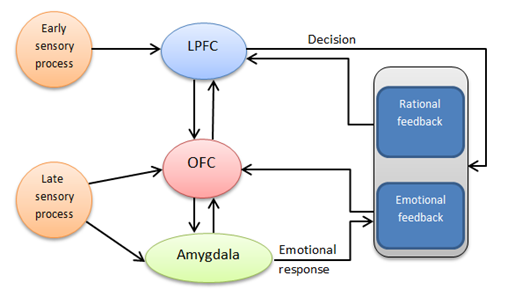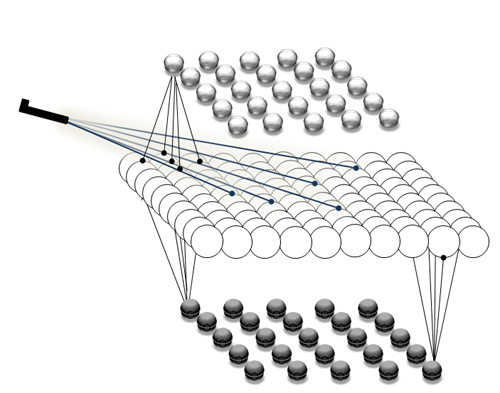Contact
Hans Liljenström, Prof. Dept. of Energy and Technology, SLU hans.liljenstrom@slu.se, +46 (0)18-671728, +46 (0)73-654 7977
The neural networks of the three modeled brain structures control DM with respect to some individual and environmental parameters. Stored emotional/rational experiences and individual principles are the basis of the attitude formation. Internal states such as fatigue, anger, happiness, etc. are considered as influential parameters on emotional decision. The self-control power, the contribution of emotion and rationality in making decisions, determines the result of the competition between these two systems. Considering the human being as an isolated agent, internal stimuli and environmental conditions (e.g. availability of options) are the only parameters affecting the behaviour.
Several key mental processes are involved in decision making (DM). Our objective is to contribute to an understanding of the relation between individual decisions of citizens and the decisions to be taken by policy makers. Our computational model includes effects of personal factors, behavior and environmental factors, based on neural structures, dynamics and functions.
Our main approach is using neuro-computational methods to tackle personal factors and behavior of individuals in DM. At the individual level, we have used Kahneman’s ideas of “thinking fast and slow”, as a paradigm when modeling the interaction of emotion and cognition in DM. The amygdala, orbitofrontal cortex (OFC) and lateral prefrontal cortex (LPFC) were considered as the major neural structures underlying decision making. The interaction of the first two structures plays a remarkable role in the emotion perception and the emotional response, while the rational decisions are evolved at the latter structure. The resultant of emotional and rational selections infers the final decision making strategy.

The model is intended to represent an adaptive DM under varying internal and external contexts. Experimental results indicate the involvement of different neural structures in the DM process, but to simplify the model, we focus our attention on three of the most crucial neural structures discussed above (amygdala, OFC and LPFC). The model takes into account the perception-action cyclic process, which involves both emotional and cognitive aspects, and is modeled as an interaction between System 1 (amygdala and OFC) and System 2 (LPFC).
The structures and dynamics of the three brain areas are modeled with attractor neural networks and mesoscopic neurodynamics (see below). Oscillatory rhythms encode information related to perception, cognition and emotional associations in our model. The oscillatory network behavior is a result of the interaction between excitatory and inhibitory neural populations (network nodes), as described below, and in more detail in Liljenström (1991, 2010). The network activity can be envisioned as local field potentials (LFP) or electroencephalogram (EEG) readouts (Liljenström, 2010, 2012).
The model used is based on a previously developed cortical neural network model (Liljenström, 1991), which here has been extended and modified to mimic the structures of amygdala, OFC and LPFC, respectively.

The upper and lower layers each consists of 25 inhibitory nodes and the middle layer of 100 excitatory nodes. The external inputs stimulate (a subset of) the excitatory nodes. The stimulation of excitatory nodes initiates the activity of the system, and in turn excites inhibitory nodes, resulting in an oscillatory excitation-inhibition balance.
For more information contact:
Hans Liljenström, Prof. Dept. of Energy and Technology, SLU hans.liljenstrom@slu.se, +46 (0)18-671728, +46 (0)73-654 7977